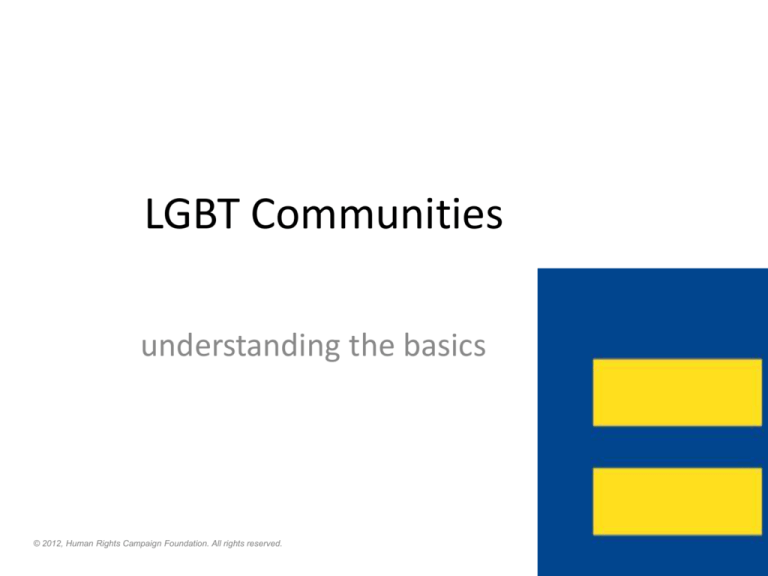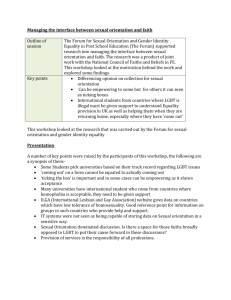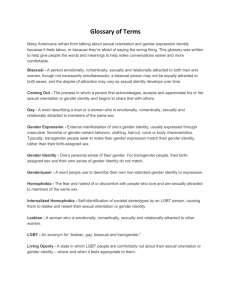
LGBT Communities
understanding the basics
© 2012, Human Rights Campaign Foundation. All rights reserved.
here‘s what we’ll do
Introduction to the LGBT Community
“What does it mean to be LGBT?”
“Who makes up the community?”
“What is life like for LGBT people in America today?”
Building Inclusion Skills
Applying the learning to specific HRSA contexts
Helpful resources for growth
LGBT people in society
Transgender
words, words, words
LGBT/A - An acronym for “Lesbian, LGBT, Bisexual, and
Transgender” and sometimes “Ally” (also written as GLBT/A).
Lesbian - A woman who is emotionally, romantically, sexually, and
relationally attracted to other women.
Gay - A man or woman who is emotionally, romantically, sexually,
and relationally attracted to members of the same sex.
Bisexual - A person who is emotionally, romantically, sexually and
relationally attracted to both men and women, though not
necessarily simultaneously; a bisexual person may not be equally
attracted to both sexes, and the degree of attraction may vary as
sexual identity develops over time.
…and a few more words
Transgender - A term describing a broad range of people
who experience and/or express their gender differently from
their birth-assigned sex or more generally from what most
people expect. It is an umbrella term that includes people
who are transsexual or otherwise gender-variant.
Ally- A person who is not LGBT but who supports and honors
LGBT diversity, acts accordingly to challenge sexual
orientation and gender identity-based bias (e.g. remarks and
behaviors) and explores and understands these forms of bias
within him- or herself
…and just a few more words
Gender expression - All of the external characteristics and
behaviors that are typically attributed to gender, such as dress,
grooming, mannerisms, speech patterns and social interactions.
Social or cultural norms can vary widely and some characteristics
that may be accepted as masculine, feminine or neutral in one
culture may not be assessed similarly in another.
Gender identity - A person’s innate, deeply felt psychological
identification as male or female, which may or may not
correspond to the person’s body or what sex was originally listed
on a person’s birth certificate.
Sexual orientation - Refers to an individual’s physical and/or
emotional attraction to the same and/or different gender.
sex & gender
Gender expression
Gender Identity
Sexual orientation
Sex
sex & gender
Gender expression
Bar one represents 50 percent of those
gender expression are categorized as
gender variant.
Gender Identity
Bar two represents 50 percent of
those gender identity are categorized
as genderquee or agender.
Sexual orientation
Bar three represents 50 percent of
those sexual orientation are
categorized as bisexual or asexual.
Sex
Bar four represents 50 percent of those
categorized as sex are intersex.
straight, masculine man
Gender expression
Bar one represents 95 percent of those
gender expression are categorized as
straight masculine male.
Gender Identity
Bar two represents 95 percent of those
gender identity are categorized as straight.
Sexual orientation
Bar three represents 5 percent of those
sexual orientation are categorized as straight
masculine male.
Sex
Bar four represents 95 percent of those
categorized as sex are straight masculine
male.
bisexual, feminine woman
Gender expression
Bar one represents 5 percent of those
gender expression are categorized as
bisexual feminine woman.
Gender Identity
Bar two represents 5 percent of those
gender identity are as bisexual feminine
woman.
Sexual orientation
Bar three represents 50 percent of those
sexual orientation are categorized as
bisexual feminine woman.
Sex
Bar four represents 5 percent of those
categorized as sex are bisexual feminine
woman.
straight, masculine, transgender man
Gender expression
Bar one represents 95 percent of those
gender expression are categorized as
straight, masculine, transgender man.
Gender Identity
Bar two represents 95 percent of those
gender identity are as straight, masculine,
transgender man.
Sexual orientation
Bar three represents 5 percent of those
sexual orientation are categorized as
straight, masculine, transgender man.
Sex
This person was assigned sex 'female' at
birth but transitioned later to sex 'male' so
that his physical sex might align with his
gender identity
so how many LGBT people are there?
presumptions, assumptions, and myths
Myth #1: Being lesbian, gay, bisexual and/or transgender are
“choices.”
Reality—Sexual orientation and gender identity are no more
choices then being right handed or having brown eyes. The
choice lies in deciding how open to be with family
members, friends, co-workers and others.
Myth #2: LGBT people don’t have families or kids.
Reality— According to Williams Institute, based on the 2010
Census, approximately 20% of same-sex couples are raising
nearly 250,000 children. The American Psychological
Association and other major medical and scientific
researchers have stated that children of LGBT and lesbian
parents are as mentally healthy as children raised by
straight parents.
presumptions, assumptions, and myths
Myth #3: LGBT people are protected by federal and state laws.
Reality—Sexual orientation and gender identity are not protected
classes under federal non-discrimination and non-harassment
legislation. While some states include sexual orientation and
gender identity/expression in their local laws, the majority of
states still have no such protections.
Myth #4: A discussion about sexual orientation or gender identity
has no place in the work environment. These are private
matters.
Reality– Sexual orientation is discussed every day in the work
environment when coworkers discuss their families and plans for
the weekend. Every time a coworker talks about his/her
husband or wife, it is a declaration of their sexual orientation. A
person’s sexual orientation is an integral part of their identity
and cannot be left at home. Gender identity and expression
come up just as frequently, from references to one’s own gender
to pronoun use.
presumptions, assumptions, and myths
Myth #5: You can tell if someone is LGBT.
Reality—The LGBT community is a diverse and open
community made up of people from every race, gender and
nationality. You cannot assume someone’s sexual
orientation or gender identity based on the way they look,
act, dress, speak, their interests and hobbies or their
friends.
Myth #6: We have an inclusive culture so LGBT employees and
clients are treated equally and fairly.
Reality– Discrimination & harassment based on sexual
orientation and gender identity/expression may occur in
organizations that have very inclusive policies and practices
around other dimensions of diversity. Sexual orientation
and gender identity are some of the most misunderstood
and invisible dimensions of diversity in many organizations.
how do sexual orientation
and gender identity
affect our day-to-day lives?
discrimination in…
employment
benefits
relationship recognition
public services
adoption
credit
public accommodations
discrimination in…
employment
benefits
relationship recognition
public services
adoption
credit
public accommodations
what we see in others
GENDER EXPRESSION
SEX
GENDER IDENTITY
SEXUAL ORIENTATION
what we see in others
• learning not to assume
everyone is like us is
the first step to respect
and true inclusion GENDER EXPRESSION
SEX
GENDER IDENTITY
SEXUAL ORIENTATION
learning not to assume everyone is like us is the
first step to respect and true inclusion
what is your gender?
male
female
what is your gender?
male
female
other
decline to answer
?
When do you need information
about gender?
?
do you need to put people in boxes?
(sometimes, yes – but often, no)
what is your gender?
_______________
What assumptions might you be making about
others’ sexual orientation or gender identity in
your work?
How might your interactions with
others at work change if you
stopped making assumptions
about their sexual orientation
and gender identity?
cultural competence
When a person…
can identify the right knowledge,
possesses that knowledge,
can apply it appropriately to the specific
relational situation at hand and
can do so consistently across engagements
then that person is
culturally competent.
resources for self-learning
Straight Guide to LGBT Americans
Transgender Americans: A Handbook for Understanding
Resource Guide to Coming Out for African Americans
Guía de Recursos Para Salir Del Clóset
Transgender Inclusion in the Workplace
…and many more @
www.hrc.org
Allyson Robinson
allyson.robinson@hrc.org
@allysonrobinson
August 2012






